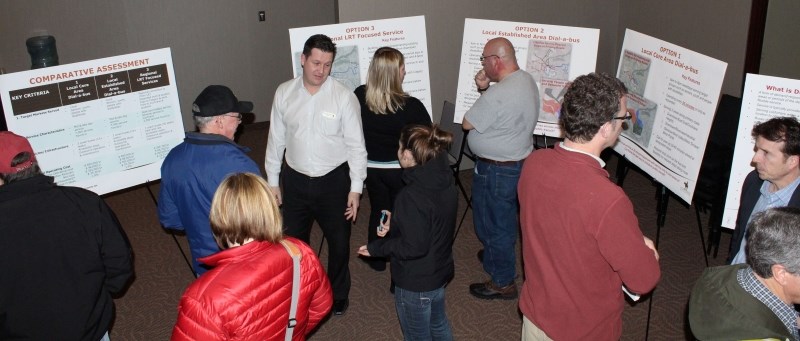And then there were three.
After what seemed like a lengthy hiatus, transit is back in the public forum. With administration having narrowed the choices down to three, they are now looking for your input.
The three alternatives are as follows:
1) Local dial-a-bus serving the core areas of Cochrane operating between 9 a.m. and 6 p.m. with 30-minute frequencies.
2) Local dial-a-bus servicing the established areas of Cochrane operating between 9 a.m. and 6 p.m. with 60-minute frequencies.
3) Regional peak and limited midday transit service operating between Cochrane and Crowfoot LRT (Calgary), with a conveniently located park-and-ride in town.
The first two options represent the local services administration believed would best suite current need, while the third is a commuter alternative; all information was based on the public engagement effort the town conducted on transit.
“We want to present to council by March 25,” said Mike Korman, economic development manager for the Town of Cochrane, on which of the three options should be moved forward.
During a March 6 open house on these alternative transit plans, attendees were asked to fill out a questionnaire ranking the three options being offered.
Town councillors Jeff Toews and Ivan Brooker, who both attended the open house, said that from what they could see at the time, they would be open to supporting option two.
“Let’s start with option two and see how it works,” said Toews, who conducted his own transit engagement and aimed to see the cost to taxpayers somewhere around $30 per year.
Toews said the second option was offered the best coverage as far as routes, reaching the majority of people who need the service, like seniors and youth. At a cost of $35.30 per taxpayer, it is also in his desired price range.
“It at least covers all the parts of town,” Brooker said of option two.
Both option one and two have equal costs, at a 1.9 per cent increase in yearly taxes, while for a inter-city service, taxpayers would see a .9 per cent increase per year.
The reason the first two options have alike costs is because option one has more recurrent frequencies at every 30 minutes, but has less route coverage, while option two covers more ground but only runs every hour.
Originally, when transit was first passed last year before eventually being rescinded, the plan called for 14,300 hours of service. The two local options now on the table cut that number in half, at 7,000 hours.
Asked why the town did not propose a mix of both local and commuter transit, Korman said they did not want to water down what service they do end up providing, but rather offer the best of one option that they could.
What routes the bus would travel was based on targeting areas with the greatest need in the community. The core area in option two, for example, reach 60 per cent of Cochrane residents.
Neighbourhoods such as Fireside and Riversong would not have a bus service, as the town believes some of the newer areas of Cochrane do not hold a high enough population density yet. Mayor Truper McBride has indicated that council is working with developers to ensure neighbourhood plans are developed so that they can one day accommodate a transit system.
Dial-a-bus is a form of demand-responsive transit that services low-demand areas of a community. The buses do not follow a set route, but rather a path to pick up and drop off based on the request.
Trips for dial-a-bus must be requested about 30-60 minutes in advance and occur at designated stops along a defined route. If there is a high enough demand along a particular service path, it can be converted into a conventional bus route.
Red Deer, St. Albert and Medicine Hat all have dial-a-bus operations.
The annual operating costs for the two local transit options are $490,000. With an estimated $98,000 recovered from the fare-box, the net cost to the town is $392,000 per year. The province’s Municipal Sustainability Initiative funding has also provided $100,000 for a transit system.
Though the cost of the fare has not yet been established, it has been estimated to be somewhere between $2-$2.75.
Three small buses – with approximately 15 seats – would be purchased by the town for a local service, compared to one coach bus that could occupy 50 passengers for the inter-city option.
Prior to the March 15 deadline, visit cochrane.wufoo.com/forms/x7w4z1/ to provide your feedback into the transit options.




